Submitted:
25 December 2023
Posted:
26 December 2023
You are already at the latest version
Abstract
Keywords:
1. Introduction
2. Methods
2.1. Study Site
2.2. Fieldwork
2.3. Data Analyses
3. Results
3.1. Survey Effort
3.2. Sculpin Age Structure
3.3. Adult Sculpin Sex Ratios and Size Differences
3.4. Sculpin CPE Relative Abundances
4. Discussion
5. Conclusions
Funding
Data Availability Statement
Acknowledgments
Conflicts of Interest
Ethics approval – Compliance with ethical standards
References
- Thronson, A.; Quigg, A. Fifty-five years of fish kills in coastal Texas. Estuaries Coasts 2008, 31, 802–813. [CrossRef]
- La, V.T.; Cooke, S.J. Advancing the science and practice of fish kill investigations. Rev. Fish. Sci. 2011, 19, 21–33. [CrossRef]
- Phelps, N.B.D.; Bueno, I.; Poo-Muñoz, D.A., Knowles, S.J.; Massarani, S.; Rettkowski, R.; Shen, L.; Rantala, H.; Phelps, P.L.F.; Escobar, L.E. Retrospective and predictive investigation of fish kill events. J. Aquat. Anim. Health 2019, 31, 61–70. [CrossRef]
- Meade, R. Fish and invertebrate recolonization in a Missouri prairie stream after an acute pollution event. N. Am. J. Fish. Manage. 2004, 24, 7–19. [CrossRef]
- Schnaser, A.C.; Mundahl, N.D. Recovery of a headwater stream population of brown trout after a fish kill in southeastern Minnesota, USA. Environ. Biol. Fish. 2022, 105, 1179–1192. [CrossRef]
- Hunt, L. South Branch Whitewater River unified fish kill response. Minnesota Department of Agriculture, Saint Paul, Minnesota, USA. 2015. https://files.dnr.state.mn.us/areas/fisheries/lanesboro/unified-fish-kill-response12-22-15.pdf Accessed 21 December 2021.
- Roell, M.J.; Orth, D.J. The roles of predation, competition, and exploitation in the trophic dynamics of a warmwater stream: a model synthesis, analysis, and application. Hydrobiologia 1994, 291, 157–178. [CrossRef]
- Fitzgerald, D.G.; Kott, E.; Lanno, R.P.; Dixon, D.G. A quarter century of change in the fish communities of three small streams modified by anthropogenic activities. J. Aquat. Ecosyst. Stress Recovery 1997, 6, 111–127. [CrossRef]
- Cooke, S.J.; Bunt, C.M.; Hamilton, S.J.; Jennings, C.A.; Pearson, M.P.; Cooperman, M.S.; Markle, D.F. Threats, conservation strategies, and prognosis for suckers (Catostomidae) in North America: insights from regional case studies of a diverse family of non-game fishes. Biol. Conserv. 2005, 121, 317–331. [CrossRef]
- Peterson, J.T.; Bayley, A.B. Colonization rates of fishes in experimentally defaunated warmwater streams. Trans. Am. Fish. Soc. 1993, 122, 199–207.
- Winona Daily News. DNR: Whitewater trout stream that saw fish kill is recovering. Winona Daily News, Winona, Minnesota, USA. 2016. https://www.winonadailynews.com/news/local/dnr-whitewater-trout-stream-that-saw-fish-kill-is-recovering/article_3bf19ec9-ec08-58d2-80f0-2bbd6be1a15c.html Accessed: 21 December 2021.
- Freeman, M.; Elkins, D.; Maholland, P.; Butler, Z.; Kleinhans, M.; Skaggs, J.; Stowe, E.; Straight, C.; Wegner, S. Slow recovery of headwater-stream fishes following a catastrophic poisoning event. J. Fish. Wildl. Manage. 2021, 12, 362–372. https://doi.org/10.3996/JFWM-20-080.
- Mundahl, N.D.; Ingersoll, C.G. 1989 Home range, movements, and density of the central stoneroller, Campostoma anomalum, in a small Ohio stream. Environ. Biol. Fish. 1989, 24, 307–311. [CrossRef]
- Rasmussen, J.E.; Belk, M.C. Individual movement of stream fishes: linking ecological drivers with evolutionary processes. Rev. Fish. Sci. Aquac. 2017, 25, 70–83. [CrossRef]
- De Fries, L.; Camana, M.; Hartz, S.M.; Becker, F.G. Heterogenous movement by a small non-migratory stream fish. Environ. Biol. Fish. 2022, 105, 1873–1885. [CrossRef]
- Mundahl, N.D.; Ingersoll, C.G. Early autumn movements and densities of johnny (Etheostoma nigrum) and fantail (E. flabellare) daters in a southwestern Ohio stream. Ohio J. Sci. 1983, 83, 103–108.
- Ingersoll, C.G.; Hlohowskyj, I.; Mundahl, N.D. Movements and densities of the darters Etheostoma flabellare, E. spectabile, and E. nigrum during spring spawning. J. Freshw. Ecol. 1984, 2, 345–351.
- Keeler, R.A.; Breton, A.R.; Peterson, D.P.; Cunjak, R.A. Apparent survival and detection estimates for PIT-tagged slimy sculpin in five small New Brunswick streams. Trans. Am. Fish. Soc. 2007, 131, 281–292. [CrossRef]
- Gray, M.A.; Curry, R.A.; Arciszewski, T.J.; Munkittrick, K.R.; Brasfield, S.M. The biology and ecology of slimy sculpin: a recipe for effective environmental monitoring. FACETS 2018, 3, 103–127. [CrossRef]
- Wallace, R.L.; McAllister, D.E.; and Rankin, M. Cottus cognatus Richardson, slimy sculpin, p. 808. In Lee, D.S.; Gilbert, C.R.; Hocutt, C.H.; Jenkins, R.E.; McAllister, D.E.; Stauffer Jr., J.R. Atlas of North American freshwater fishes. North Carolina Biological Survey Publication #1980-12. 1980.
- Page, L.M.; Burr, B.M. A field guide to freshwater fishes: North America north of Mexico. Houghton Mifflin Company, Boston, Massachusetts, USA. 1991. [CrossRef]
- Eddy, S.; Underhill, J.C. Northern fishes, with special reference to the Upper Mississippi Valley. University of Minnesota Press, Minneapolis, 1974.
- Kelly, B.B.; Siepker, M.J.; Weber, M.J. 2023. Effects of non-native Salmo trutta and multiscale habitat factors on native fishes in the Driftless Area. Can. J. Fish. Aquat. Sci. 2023, 80, 942–957. [CrossRef]
- Mundahl, N.D.; Thomas, K.N.; Mundahl, E.D. Selected habitats of slimy sculpin in coldwater tributaries of the Upper Mississippi River in Minnesota. Am. Midl. Nat. 2012, 168, 144–161. [CrossRef]
- Gray, M.A.; Munkittrick, K.R. An effects-based assessment of slimy sculpin (Cottus cognatus) populations in agricultural regions of northwestern New Brunswick. Water Qual. Res. J. Canada 2005, 40, 16–27. [CrossRef]
- Clarke, A.D.; Telmer, K.H.; Shrimpton, J.M. Movement patterns of fish revealed by otolith microchemistry: a comparison of putative migratory and resident species. Environ. Biol. Fish. 2015, 98, 1583–1597. [CrossRef]
- Weinstein, S.Y.; Coombs, J.A.; Nislow, K.H.; Riley, C.; Roy, A.H.; Whiteley, A.R. Evaluating the effects of barriers on slimy sculpin movement and population connectivity using novel sibship-based and traditional genetic metrics. Trans. Am. Fish. Soc. 2019, 148, 1117–1131. [CrossRef]
- Snook, V. Fish kill incident report: Garvin Brook at Farmer’s Community Park. Minnesota Department of Natural Resources-Fisheries, Lanesboro, Minnesota, USA. 2019.
- Burri. T.; Fier-Tucker, D.; Ganske, L.; Hunt, L.; Wieland, R. Response to 2019 fish kill on Garvin Brook, Winona County. Minnesota Pollution Control Agency, Saint Paul, Minnesota, USA. 2020 https://www.pca.state.mn.us/sites/default/files/tdr-gl-22.pdf.
- Minnesota Department of Natural Resources. Garvin Brook aquatic management area. 2023. https://www.dnr.state.mn.us/amas/detail_report.html?id=AMA00210 (accessed 10 December 2023).
- Minnesota Pollution Control Agency. Agencies conclude investigation: contaminated runoff suspected in Garvin Brook fish kill. Minnesota Pollution Control Agency, Saint Paul, Minnesota, USA. 2020. https://pca.state.mn.us/news/agencies-conclude-investigation-contaminated-runoff-suspected-garvin-brook-fish-kill (Accessed 13 January 2022).
- Arciszewski, T.J.; Gray, M.; Munkittrick, K.; Baron, C. Guidance for the collection and sampling of slimy sculpin (Cottus cognatus) in northern Canadian lakes for environmental effects monitoring (EEM). Canadian Technical Report of Fisheries and Aquatic Sciences 2909. Fisheries and Oceans Canada, Winnipeg, Manitoba, Canada. 2010.
- Breen, M.J.; Ruetz III, C.R.; Thompson, K.J.; Kohler, S.L. Movements of mottled sculpins (Cottus bairdii) in a Michigan stream: how restricted are they? Can. J. Fish. Aquat. Sci. 2009, 66, 31–41.
- Mousseau, T.A.; Collins, N.C.; Cabana, G. A comparative study of sexual selection and reproductive investment in the slimy sculpin, Cottus cognatus. Oikos 1987, 51, 156–162. [CrossRef]
- Majeski, M.J.; Cochran, P.A. Spawning season and habitat use of slimy sculpin (Cottus cognatus) in southeastern Minnesota. J. Freshw. Ecol. 2009, 24, 301–307. [CrossRef]
- Petty, T.D.; Grossman, G.D. Restricted movement by mottled sculpin (Pisces: Cottidae) in a southern Appalachian stream. Freshw. Biol. 2004, 49, 631–645.
- Schmetterling, D.A.; Adams, S.B. Summer movements within the fish community of a small montane stream. N. Am. J. Fish. Manag. 2004, 24, 1163–1172.
- Larimore, R.W.; Childers, W.F.; Heckrotte, C. Destruction and re-establishment of stream fish and invertebrates affected by drought. Trans. Am. Fish. Soc. 1959, 88, 261–285. [CrossRef]
- Harrel, R.C.; Davis, B.J.; Dorris, T.C. Stream order and species diversity of fishes in an intermittent Oklahoma stream. Am. Midl. Nat. 1967, 78, 428–436.
- Minnesota Department of Natural Resources. Southeast Minnesota Sculpin Reintroduction Plan. Minnesota Department of Natural Resources–Fisheries, Lanesboro, Minnesota, USA. 2003. https://files.dnr.state.mn.us/areas/fisheries/lakecity/semn_sculpin_reintroplan.pdf.
- Huff, D.D.; Miller, L.M.; Vondracek, B. Patterns of ancestry and genetic diversity in reintroduced populations of the slimy sculpin: implications for conservation. Conserv. Genet. 2010, 11, 2379–2391.
- Huff, D.D.; Miller, L.M.; Chizinski, C.J.; Vondracek, B. 2011. Mixed-source reintroductions lead to outbreeding depression in second-generation descendants of a native North American fish. Mol. Ecol. 2011, 20, 4246–4258. [CrossRef]
- Mundahl, N.D.; Mundahl, D.E.; Merten, E.C. Success of slimy sculpin introductions: influence of feeding and diets. Am. Midl. Nat. 2012, 168, 162-183.
- Nerbonne, B. Personal communication. Minnesota Department of Natural Resources–Fisheries, Saint Paul, Minnesota, USA. 2023.
- Detenbeck, N.; DeVore, P.W.; Niemi, G.J.; Lima, A. Recovery of temperate-stream fish communities from disturbance: a review of case studies and synthesis of theory. Environ. Manag. 1992, 16, 33–53. [CrossRef]
- Anderson, C.S. The structure of sculpin populations along a stream size gradient. Environ. Biol. Fish. 1985, 13, 93-102. [CrossRef]
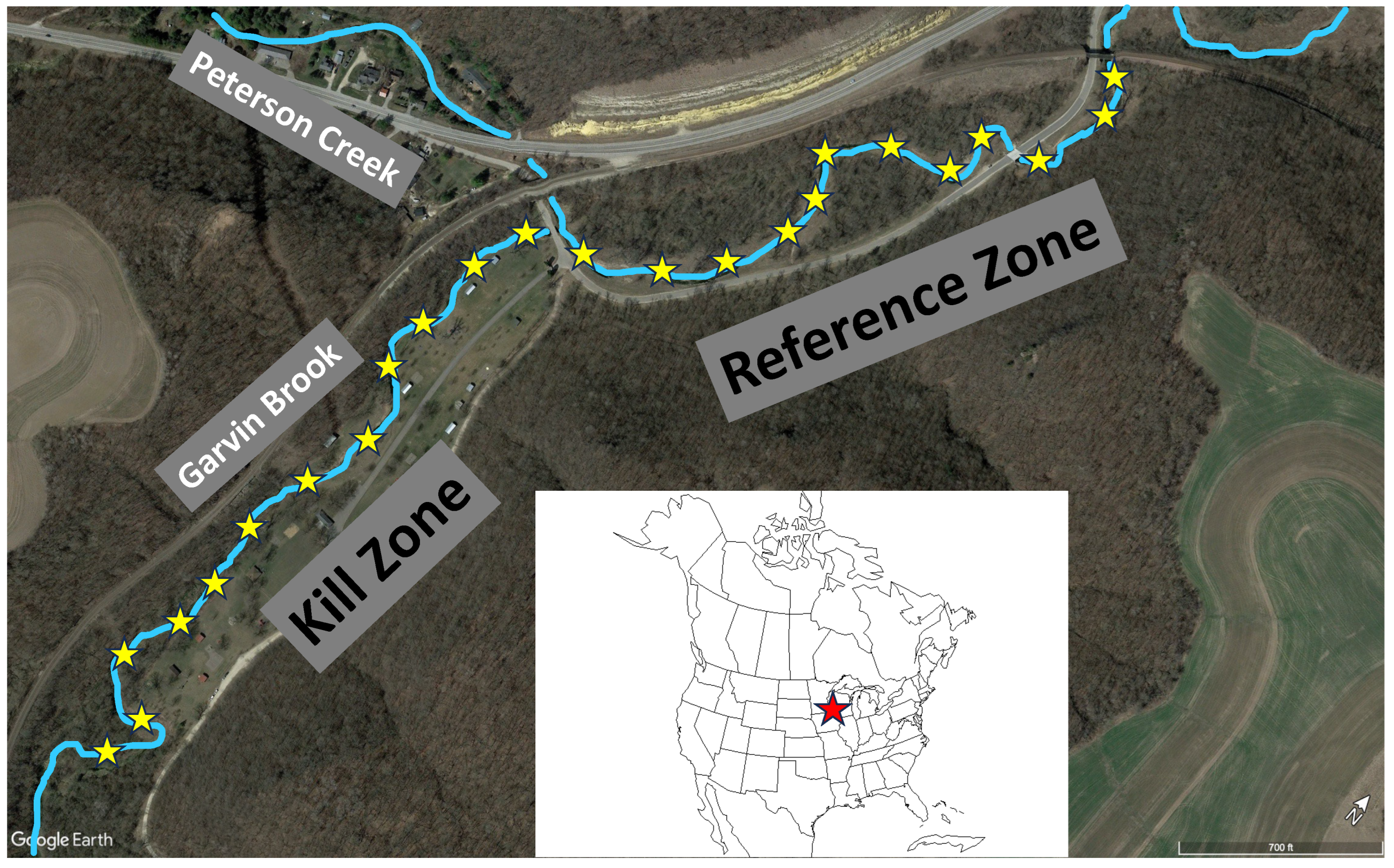
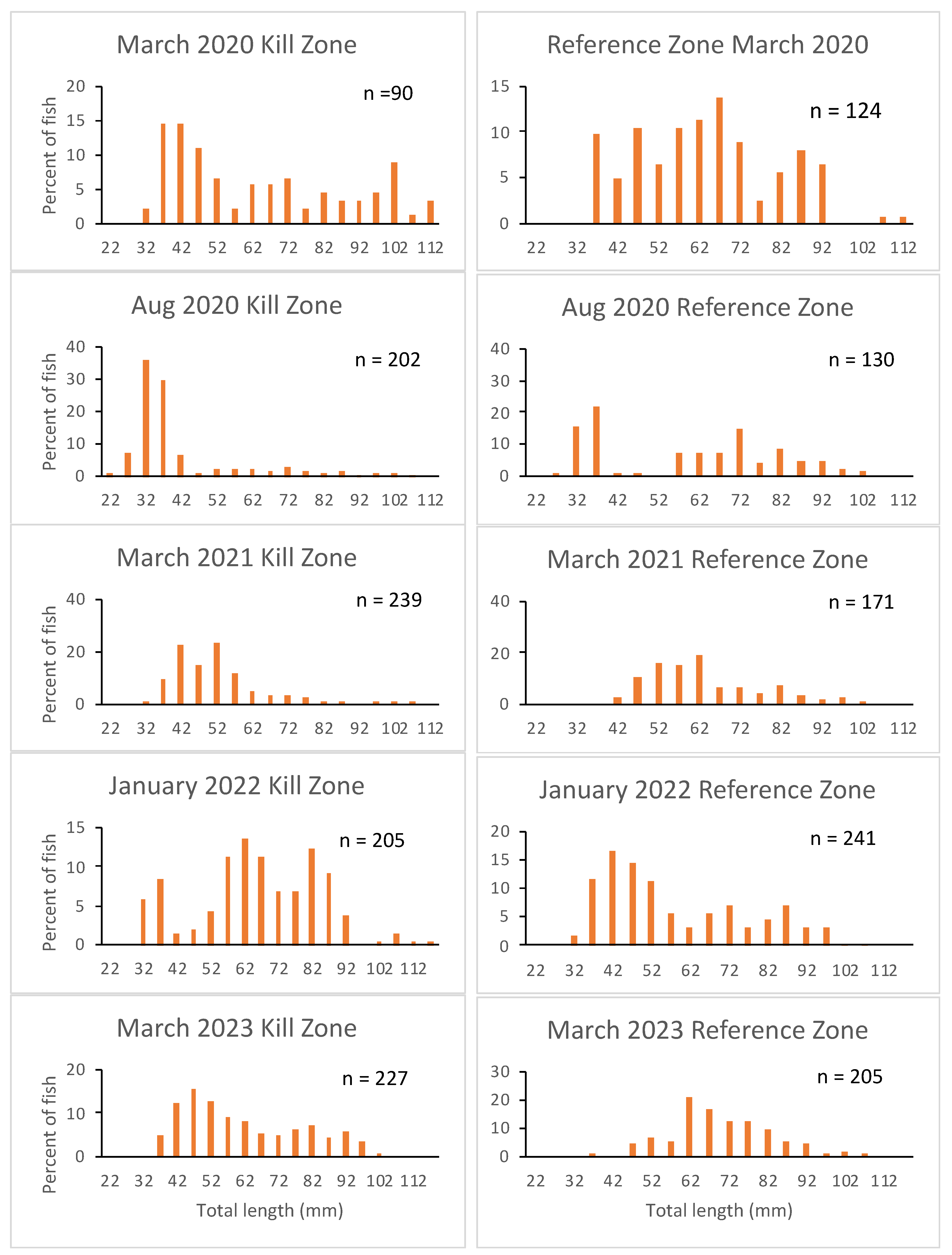
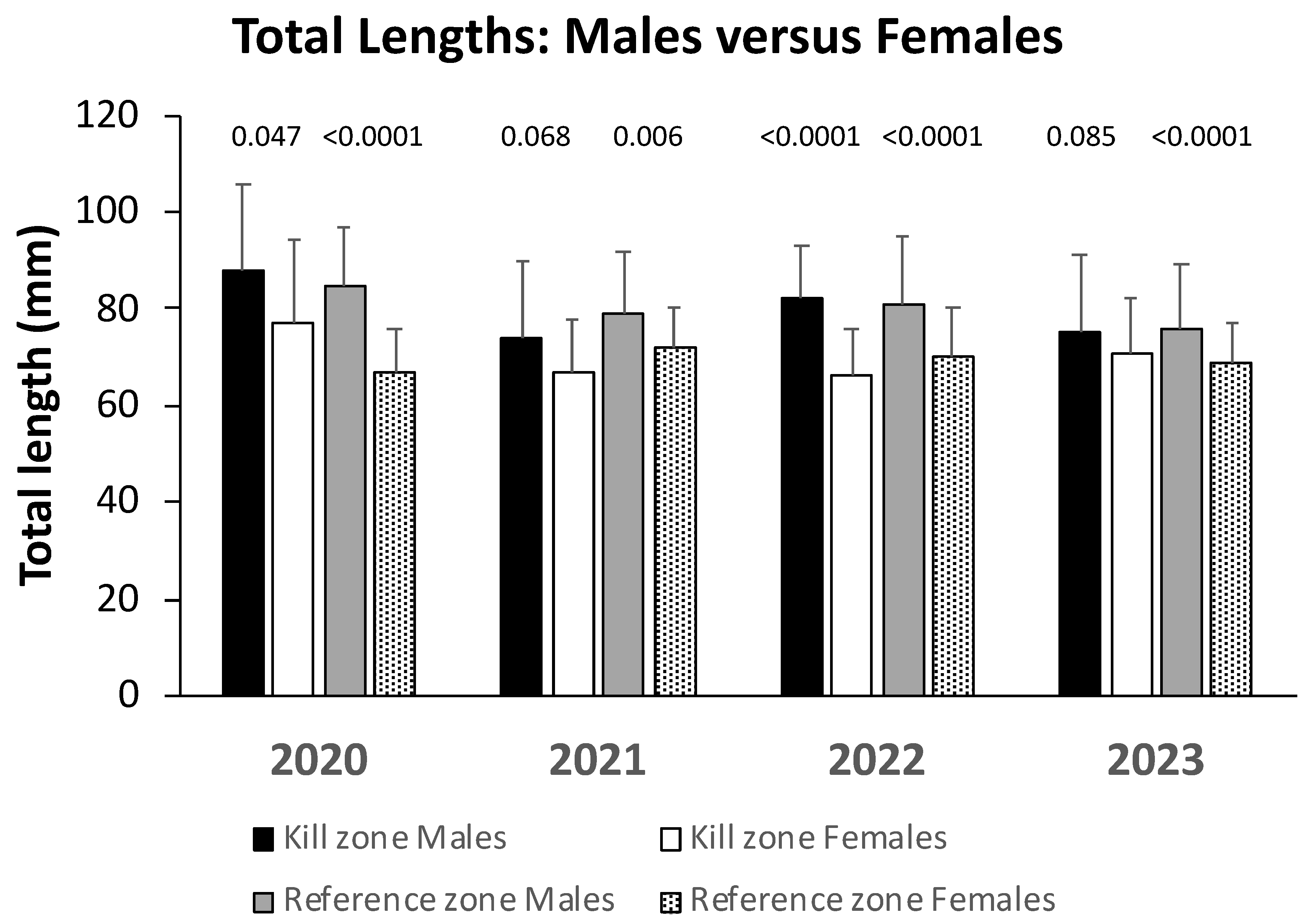
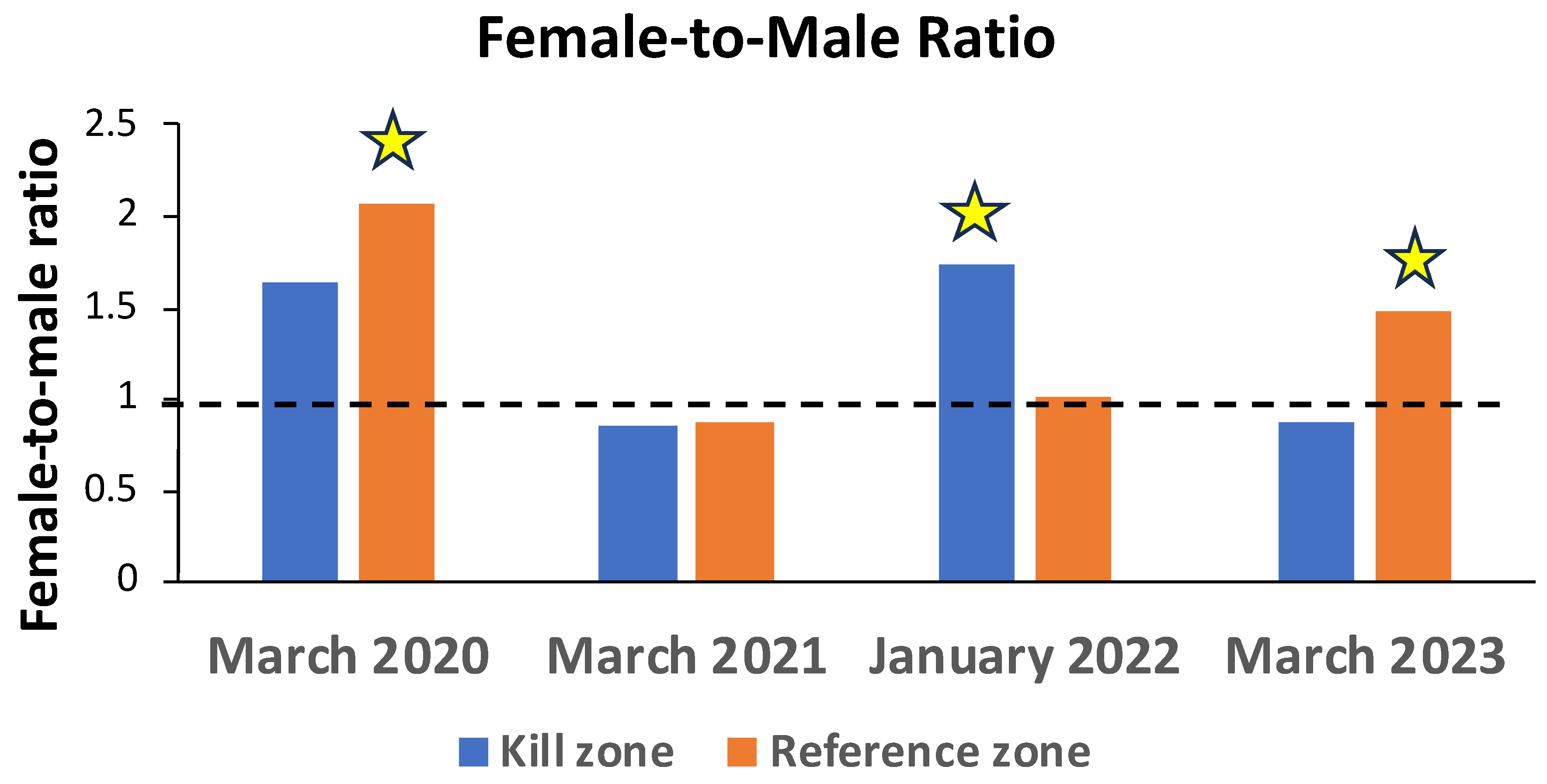
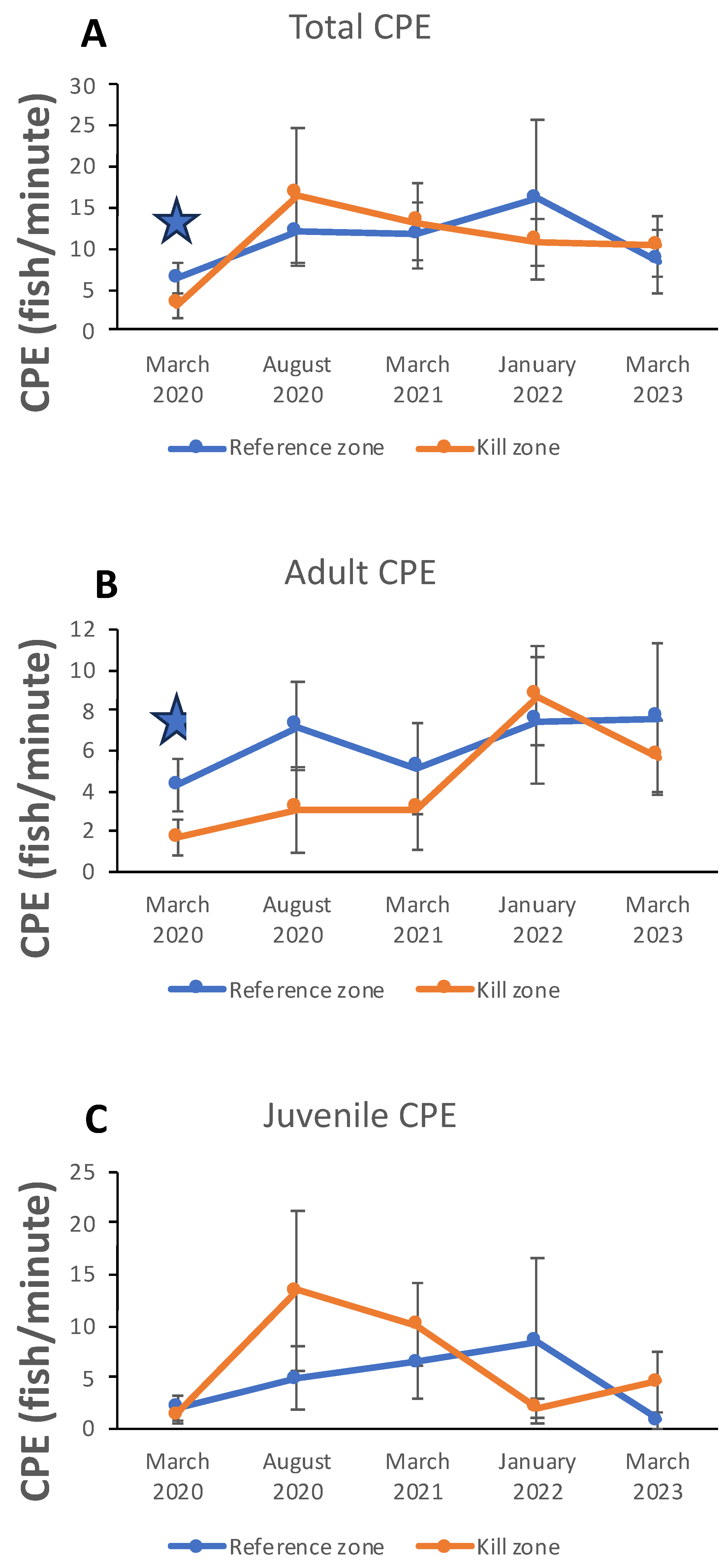
| Date | Kill zone | N | Reference | N | t value | P | |||
|---|---|---|---|---|---|---|---|---|---|
| Mar-20 | 64 (24) | 90 | 64 (17) | 124 | 0.05 | 0.959 | |||
| Aug-20 | 41 (17) | 202 | 59 (22) | 130 | 7.97 | <0.001 | |||
| Mar-21 | 52 (13) | 239 | 63 (14) | 171 | 8.55 | <0.001 | |||
| Jan-22 | 66 (18) | 205 | 58 (19) | 241 | 4.39 | <0.001 | |||
| Mar-23 | 70 (13) | 227 | 61 (18) | 205 | 5.66 | <0.001 |
| Kill zone | Reference zone | |||||||
|---|---|---|---|---|---|---|---|---|
| Date | Males | Females | Males | Females | X2 | P | ||
| Mar-20 | 19 | 31 | 27 | 56 | 0.43 | 0.521 | ||
| Mar-21 | 29 | 25 | 40 | 35 | 0.002 | 0.967 | ||
| Jan-22 | 68 | 99 | 54 | 55 | 2.08 | 0.149 | ||
| Mar-23 | 69 | 60 | 74 | 110 | 5.38 | 0.02 |
| Total CPE | Adult CPE | Juvenile CPE | |||||||
|---|---|---|---|---|---|---|---|---|---|
| Date | t | P | t | P | t | P | |||
| Mar-20 | 4.49 | 0.0002 | 5.48 | <0.0001 | 1.54 | 0.14 | |||
| Aug-20 | 1.66 | 0.111 | 4.65 | 0.0001 | 3.56 | 0.002 | |||
| Mar-21 | 0.9 | 0.375 | 2.32 | 0.03 | 2.42 | 0.024 | |||
| Jan-22 | 1.79 | 0.097 | 1.07 | 0.298 | 2.77 | 0.018 | |||
| Mar-23 | 1.18 | 0.252 | 1.57 | 0.136 | 4.27 | <0.0001 |
| Zone/statistic | Total CPE | Adult CPE | Juvenile CPE | ||||||
|---|---|---|---|---|---|---|---|---|---|
| Kill zone | |||||||||
| Slope | –0.226 | –0.136 | –0.089 | ||||||
| Y intercept | 4.5 | 2.524 | 1.976 | ||||||
| r2 | 0.276 | 0.295 | 0.141 | ||||||
| t value (one-tailed) | 1.95 | 2.05 | 1.28 | ||||||
| Degrees of freedom | 10 | 10 | 10 | ||||||
| P value | 0.04 | 0.034 | 0.115 | ||||||
| Reference zone | |||||||||
| Slope | 0.356 | 0.162 | 0.194 | ||||||
| Y intercept | 4.329 | 3.334 | 0.995 | ||||||
| r2 | 0.339 | 0.141 | 0.249 | ||||||
| t value (one-tailed) | 2.03 | 1.25 | 1.63 | ||||||
| Degrees of freedom | 8 | 8 | 8 | ||||||
| P value | 0.038 | 0.142 | 0.071 |
Disclaimer/Publisher’s Note: The statements, opinions and data contained in all publications are solely those of the individual author(s) and contributor(s) and not of MDPI and/or the editor(s). MDPI and/or the editor(s) disclaim responsibility for any injury to people or property resulting from any ideas, methods, instructions or products referred to in the content. |
© 2023 by the authors. Licensee MDPI, Basel, Switzerland. This article is an open access article distributed under the terms and conditions of the Creative Commons Attribution (CC BY) license (http://creativecommons.org/licenses/by/4.0/).





